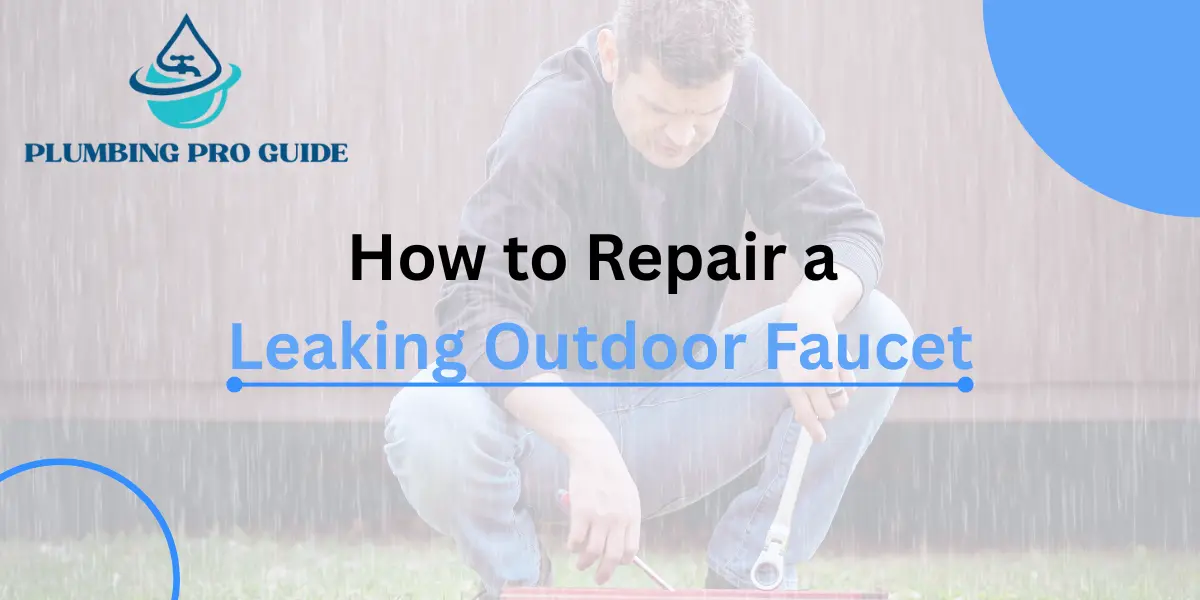To repair a leaky outdoor faucet is not just a quick fix; it’s home protection. Even a slow drip can weaken fittings, invite rust, and in colder climates, lead to freeze damage that bursts pipes. Learning how to repair a leaky outdoor faucet means keeping your water system reliable year-round, protecting your home’s exterior, and ensuring you can use your garden hose, sprinkler, or pressure washer without interruption.
Understanding Outdoor Faucet Leaks
Outdoor faucets face more stress than indoor ones. They’re exposed to weather, fluctuating temperatures, and heavy use from hoses and attachments. To repair a leaky outdoor faucet, you need to understand the types of faucets and causes of leaks.
Two main types of outdoor faucets:
-
- Standard Hose Bibs: Basic design, works well in warmer climates, but prone to freezing in winter.
-
- Frost-Free Faucets: Designed to keep water inside the house’s insulated area to prevent freezing, but are still susceptible to seal and washer wear.
An external faucet leaking can be caused by worn washers, a loose packing nut, or cracks in the faucet body from freezing temperatures.
3. Common Causes of a Leaky Outdoor Faucet
(Also applies when you repair a leaky outdoor faucet)
-
- Worn-Out Washer or O-Ring – These rubber parts naturally deteriorate and cause drips at the spout or handle.
- Loose or Damaged Packing Nut – A small nut that seals around the faucet stem; if loose, water escapes.
- Cracked Faucet Body or Spigot – Often the result of ice expansion during winter.
- Damaged Stem Washer – Located deep inside the faucet, failure here causes leaks even when turned off.
- Corroded or Worn Valve Seat – Mineral deposits can damage the sealing surface, allowing water to slip through.
- Worn or Faulty Faucet Cartridge – Modern single-handle faucets rely on a cartridge to control water flow and temperature. When this cartridge wears out or cracks, it causes constant dripping or uneven pressure, often requiring a simple faucet cartridge replacement to restore smooth operation.
Tools & Materials You’ll Need To Repair a Leaky Outdoor Faucet
| Tool/Material | Purpose |
| Adjustable wrench | Loosen/tighten faucet components |
| Screwdriver set | Remove handle screws |
| Plumber’s tape | Seal threaded connections |
| Replacement washer/O-ring | Stop leaks at the handle or spout |
| Packing string | Reseal the packing nut |
| Faucet stem | Replace if internal parts are damaged |
| Bucket & rag | Catch and wipe excess water |
Step-by-Step Guide to Repair a Leaky Outdoor Faucet
Step 1: Turn Off the Water Supply
-
- Find the shut-off valve for the outdoor faucet.
-
- It’s usually inside your home, in a basement, crawl space, utility room, or near where the faucet pipe comes through the wall.
-
- It may be a round handle (turn clockwise to close) or a lever (move to the perpendicular position to close).
-
- Find the shut-off valve for the outdoor faucet.
-
- Turn it completely off so no water can flow while you work.
Once it’s off, open the outdoor faucet briefly to drain any remaining water in the pipe.
Step 2: Remove the Faucet Handle
-
- Look for a small screw on top of or behind the handle.
-
- Some handles have a decorative cap hiding the screw — gently pry it off with a flat screwdriver.
-
- Look for a small screw on top of or behind the handle.
-
- Use a screwdriver to loosen the screw and carefully slide the handle off the stem.
Keep screws and small parts in a cup so they don’t get lost.
Step 3: Inspect All Components
Now you’ll see the stem assembly, the part that controls water flow.
Here’s what to check:
-
- Washer: A small, round rubber disc at the very tip of the stem (inside the faucet). If it’s cracked, flat, or hardened, it needs replacing.
-
- O-Ring: A thin rubber ring around the stem, just behind the threads. If it’s brittle, split, or missing, replace it.
-
- Stem Threads: The spiral grooves where the stem screws into the faucet. If they’re rusty or worn smooth, they may not seal well.
Packing Nut: A hex-shaped nut just behind the handle area. If it’s loose, it can let water leak around the stem.
Step 4: Replace Worn Parts
-
- Washer Replacement:
-
- Use a screwdriver to remove the small screw holding the washer in place at the stem’s end.
-
- Take the washer to a hardware store to get the exact same size.
-
- Washer Replacement:
Install the new washer and secure it with the screw.
-
- O-Ring Replacement:
-
- Pry the old O-ring off gently with a flat screwdriver or your fingers.
-
- O-Ring Replacement:
Slide the new O-ring in its place — you may need to apply a little silicone grease to help it fit.
-
- Packing Nut:
-
- Use an adjustable wrench to snug it slightly — not too tight, or the handle will be hard to turn.
-
- Packing Nut:
-
- Plumber’s Tape:
- Plumber’s Tape:
Wrap plumber’s tape around the stem threads 2–3 times for a better seal.
Step 5: Rebuild if Necessary
If the stem or valve seat (the inside surface where the washer seals) is badly corroded or cracked:
-
- Replace the entire stem assembly — it’s often easier than trying to repair worn threads.
-
- A valve seat tool can help you remove and replace the seat if needed.
Step 6: Reassemble and Test
-
- Slide the stem back into the faucet body and tighten it securely.
- Reattach the handle and screw it in place.
- Turn the indoor shut-off valve back on.
- Open the faucet slowly and check for leaks at both the spout and around the handle.
If it still leaks, tighten the packing nut slightly more or double-check that your washer/O-ring is seated properly. Once you repair a leaky outdoor faucet, turn the water back on.
How to Stop an Outdoor Faucet from Dripping Without Full Replacement
Sometimes you can repair a leaky outdoor faucet without rebuilding it.
Tighten the packing nut slightly to improve the seal.
Apply plumber’s tape to stem threads for a quick fix.
Use silicone grease on washers and O-rings to improve sealing.
FAQS:
Q1: How to fix an outside faucet?
You shut off the water first, disassemble the faucet, and inspect the washers or O-rings. You replace any worn parts, wrap the threads with plumber’s tape, and reassemble the faucet to stop leaks.
Q2: How to stop the outdoor faucet from dripping?
You tighten the packing nut just behind the handle, or replace the washer if it’s worn out. For leaks around the handle, you swap the O-ring.
Q3: What is the cost to repair a leaky outdoor faucet?
You spend under $10 if you do it yourself, since most parts are inexpensive. A plumber may charge more, depending on the leak’s cause and how hard it is to access the faucet.
Q4: Why is my outdoor faucet leaking when off?
A worn stem washer, faulty valve seat, or cracked stem usually causes that problem. You inspect these parts and replace any that look damaged.
Q5: Can I rebuild an outdoor faucet myself?
You can rebuild it with basic tools and parts, and if the body isn’t cracked, learning how to repair a leaky outdoor faucet yourself saves money.


